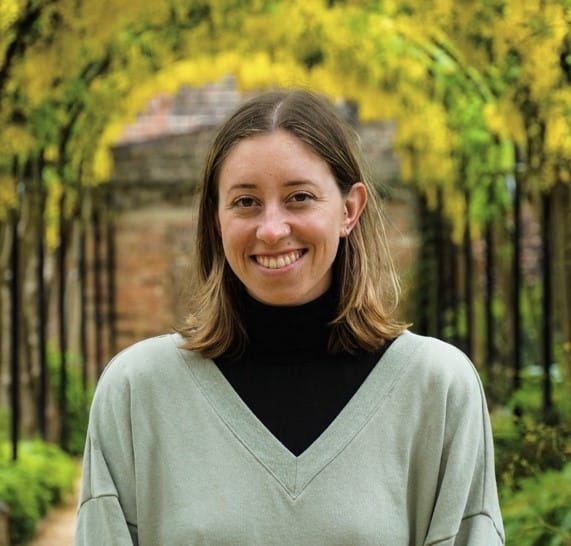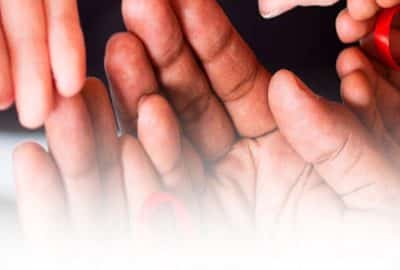How can we use sound waves to eliminate infections?
Wednesday 17th May 2023, 12.30pm
Many of us will have had to deal with a bacterial infection at some point or another. The solution? Often, antibiotics. But as the issue of antibiotic resistance becomes more and more of a concern, might there be an alternative to tackling bacterial infections with drugs? We chat to biomedical engineer Dr Sara Keller about how sound waves could potentially be used to break down bacterial cells.
Emily Elias: Getting a bacterial infection sucks. There is a whole lot of going to your doctor, getting antibiotics, taking them for weeks. Maybe they work, yada, yada, yada. But what if we stop taking pills and instead used sound waves to treat them? On this episode of The Oxford Sparks Big Questions Podcast, we’re asking, “How can we use sound waves to eliminate infections?”
Hello. I’m Emily Elias. And this is the show where we seek out the brightest minds at the University of Oxford and we ask them the big questions. For this one, we have found a researcher who loves to tinker with ultrasound.
Sara Keller: Hi. My name is Dr Sara Keller. I’m a postdoctoral researcher here at Oxford. I work in the Institute of Biomedical Engineering, which is part of the Engineering Department here at Oxford.
My background is in therapeutic ultrasound, so using typical standard ultrasound in a new way to do a wide number of things. And actually, the lab that I’m in here at Oxford kind of focuses on that. So we use therapeutic ultrasound as a method of enhancing targeted drug delivery, for example, or what I do, which is breaking up bacterial infections.
Emily: So like an infection, a regular, bog-standard infection that I would go to my doctor for, you’re looking at getting rid of it through an ultrasound?
Sara: Yes, exactly. So probably, we have all experienced bacterial infections. So strep throat is an example of a bacterial infection that is super common. Urinary tract infections, or UTIs, are also a bacterial infection, which are really, really common, and they can also be really life-threatening. So sepsis is an infection of, essentially, the blood stream, and that can be lethal.
Probably we have all heard of antibiotic resistance, in which the antibiotic drugs that have worked in the past are not as effective anymore. And so what we’re trying to do is basically bridge that gap.
We currently have antibiotics that are working but are becoming less effective. And so we want to find new ways of treating infections that might be able to solve some of those critical issues that will be appearing in the next decade or so, where infections are becoming a lot more resistant.
Emily: So how would this work in theory? Because using ultrasound is something that I wouldn’t necessarily associate with treating an infection.
Sara: Yes, for sure. I think, realistically, it’s a treatment option that would probably only exist, at least in the short term, in a clinical setting.
So one good example that I like to think of is a urinary tract infection, or a bladder infection, in which bacterial colonise the walls of the bladder or the walls of the urinary tract.
And so what we look at is using these tiny little bubbles called ‘microbubbles’ so, literally, micron-sized bubbles. And they are actually used currently clinically as ultrasound contrast agents.
So pretty much all imaging modalities, so MRI, CT etc. have contrast agents. And for ultrasound, it’s little bubbles that, when they are hit with an ultrasound wave, they oscillate.
And so how I think this technique might be used clinically is we could insert a catheter or something into the bladder, introduce microbubbles and then basically break them up with ultrasound. And the mechanical action of hitting the microbubbles with ultrasound, we think will cause physical break-up of a bacterial infection.
Emily: What would the microbubbles do exactly inside me? Like if I’m hitting them with ultrasound, what happens to them?
Sara: It’s useful to think of ultrasound as a wave of pressure. So you have oscillating positive and negative pressure. So when you put a compressible gas within that positive and negative pressure environment, and the gas being what is constrained within the bubble, the bubble will shrink and expand basically in those alternating positive and negative pressure periods. And so that shrinking and expanding is really what we’re using to facilitate this mechanical action.
And what’s really cool about bubbles is that the way in which they expand and they shrink changes, based on how much ultrasound pressure you apply. So if you’re applying a really low pressure, the oscillation might just be expand and contract, expand and contract forever.
But if you hit them with a really high pressure, then they might violently collapse and basically get destroyed. And so that violent collapse is what we’re really interested in, because we think that that can cause the most amount of mechanical force on a bacterial infection.
Emily: Violent, shaking bubbles is what will break up the infection, is the theory. But it wouldn’t hurt me and my precious, precious bladder that I want to keep safe?
Sara: Yes. I mean the really cool part about ultrasound is that, similar to how you can focus in with a magnifying glass. So, for example, I feel like as kids we might have tried to focus on sunlight with a magnifying glass to burn a piece of paper. Ultrasound works in exact the same way.
So if you focus your sound waves into a specific point in the body, then you can cause that really high-pressure environment to happen at a really localised area. And so, in that way, we can make sure that our bubbles are doing their violent collapse and oscillation in the area that we’re interested in.
Another cool part, and one of the reasons that I became really interested in using ultrasound, is the fact that it can both image and apply therapy is really exciting. So we can use what we call, “Image-guided therapy.” So you use your ultrasound imaging to be able to figure out where you should apply therapy, and then you can ramp up the pressure and cause your mechanical effect.
So it’s really a technology that you don’t have to know everything about the system before starting it. You can be a little bit more on the fly, I guess, with how you target your ultrasound wave.
So along the lines of using ultrasound as an image-guided treatment, we can also use the echoes that microbubbles emit when they’re hit with ultrasound to also monitor how effective our therapies are.
So in my previous example where we have a low-pressure ultrasound causes microbubbles to expand and contract in like a known and not very violent way, versus the violent collapse of bubbles. The bubbles emit distinct ultrasound sounds that we can then pick up and localise and characterise.
So the way that we usually like to think about it is when a bubble is oscillating in a way that is not violent, it might emit frequencies that are very discreet. For example, if we hit it with one frequency, the bubble will also emit that frequency, as well as maybe harmonics of that.
So if you’re familiar with musical instruments, the way that we think about harmonics is like octaves. So you may send a low A to the bubble and the bubble will emit that low A and also an octave above that A, so a higher A.
However, if we hit the bubble really hard with really high-pressure ultrasound, the bubble will emit that low A, as well as every other sound that goes between that lower A and the higher A. And so if we can isolate those incidents then we can know how violent the bubble was collapsing and therefore we can have an idea of how effective our therapy might be.
Emily: And does it sound musical? I know it’s ultrasound, so it’s difficult to actually put on to a podcast.
Sara: (Laughter) Yes. We wouldn’t be able to hear it, because ultrasound is beyond the frequency that we can hear. I think how it’s defined is, “Frequencies beyond the human ear.”
But yes, if we hit a bubble with, “Ahh…” then the bubble will emit like, “Ahh…” (Laughter) So it’s literally sending out octaves of sound, versus just a bunch of random noise if it’s violently collapsing. I don’t think I want to make everyone hear my interpretation of a bunch of random noise. (Laughter)
Emily: Okay. So there is a lot going on here. This all sounds quite theoretical though. Like, you are working in a lab. How do you actually spend your day trying to replicate using microbubbles to break up infections?
Sara: I grow, essentially, very small bacterial infections in a very controlled way, so I grow bacteria within a culture dish. What’s kind of cool is that we can take bacterial strains that have been isolated from specific infections. For example, we’ve got some isolates from urinary tract infections and others from infective endocarditis, so it should be, theoretically, quite similar to the types of infections that might exist clinically.
But I just grow them as individual species biofilms, which are just, I allow the bacteria to grow and propagate, as it would in any other type of environment, for two days. And then I shoot them with ultrasound.
And what I’ve been doing recently is trying to see if I can correlate the amount of bubble energy, that bubble sound, that I mentioned before so that all of the noise that the bubbles emit, if I can correlate how much noise they emit with how good our therapy is, meaning how good we are at removing bacteria from the infection model that we have.
And then we can understand like, “Okay, so we know now that this amount of ultrasound bubble activity results in this amount of bacterial loss,” and therefore we might be able to use those similar types of energies in a clinical setting. So it just gives us a better understanding of how much pressure, how much bubble, wonkiness, is really required to remove bacteria.
Emily: And when you say, “Remove bacteria,” do you mean like the bacteria is removed from that area and then could go somewhere else in the body and still be an infection? Or like properly kill it and it no longer is a danger to the human body?
Sara: Yes, that’s a really good question, and that’s exactly what we’re trying to figure out. I think one of the big questions is, “Are we actually destroying bacteria or are we just moving it?” Like if we’re just removing them and not killing them, it doesn’t mean that we’re not applying an effective therapy.
One of the challenges in just having our own human immune cells fight infections is that bacteria are really good at protecting themselves with a bunch of proteins and sugars and extra cellular junk that they use to shield themselves from our body.
And so possibly just being able to break up the infection such that our body is able to fight it back and recognise it as bad, that could be enough. Or it could be that it requires not just the ultrasound treatment, but also an antibiotic. Which again, one of the challenges of antibiotics is just penetration through an infection.
So if we’re able to open up the barriers to penetration then that could definitely help with better therapies. But these are all questions that are really pertinent and are ones that I am trying to figure out.
Emily: And it feels like each question unto itself could be a little bit of a breakthrough into figuring out how to use less antibiotics as a society?
Sara: Oh yes, totally. I mean I think one of the big thoughts in using focused ultrasound as a cancer therapy is one of the challenges of chemotherapy, which we all know, is that it can cause a lot of burden on just our healthy cells in our body. Which is why you lose hair with chemotherapy or have really challenging side-effects.
And one of the thoughts with using ultrasound as a way of mitigating that is that if you are able to push more of your drugs into a tumour, then less of the drug is going elsewhere. And so that’s kind of what we’re hypothesising with antibiotic therapy as well. Like if we can push more antibiotics into the infection that they are actually meant to hit, then maybe we can spare some of the good bacteria in the rest of our body.
Emily: Well it sounds like you’ve got a lot of sleepless nights ahead of you.
Sara: Oh, yes. (Laughter)
Emily: This podcast was brought to you by Oxford Sparks from the University of Oxford. The music by John Lyons, and a special thanks to Dr Sara Keller.
Tell us what you think about this podcast. Twitter still exists and you can find us there. We are @OxfordSparks. You can find us on Facebook and any other social media platform of your choosing. And we’ve got other cool stuff on our website, oxfordsparks.ox.ac.uk.
I’m Emily Elias. Bye for now.
Transcribed by UK Transcription.




